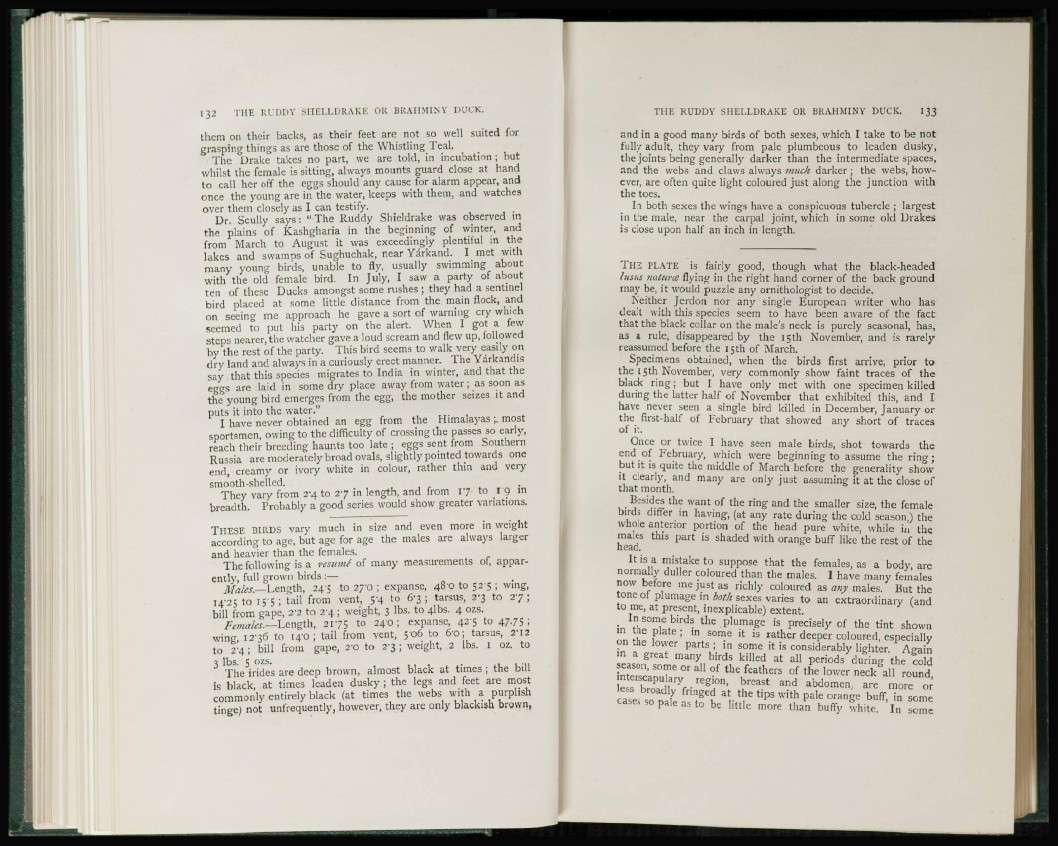
them on their backs, as their feet are not so well suited for
grasping things as are those of the Whistling Teal.
The Drake takes no part, we are told, in incubation ; but
whilst the female is sitting, always mounts guard close at hand
to call her off the eggs should any cause for alarm appear, and
once the young are in the water, keeps with them, and watches
over them closely as I can testify.
Dr. Scully says: " The Ruddy Shieldrake was observed in
the plains of Kashgharia in the beginning of winter, and
from March to August it was exceedingly plentiful in the
lakes and swamps of Sughuchak, near Yárkand. I met with
many young birds, unable to fly, usually swimming about
with the old female bird. In July, I saw a party of about
ten of these Ducks amongst some rushes ; they had a sentinel
bird placed at some little distance from the main flock, and
on seeing me approach he gave a sort of warning cry which
seemed to put his party on the alert. When I got a few
steps nearer, the watcher gave a loud scream and flew up, followed
by the rest of the party. This bird seems to walk very easily on
dry land and always in a curiously erect manner. The Yárkandis
say that this species migrates to India in winter, and that the
eggs are laid in some dry place away from water ; as soon as
the young bird emerges from the egg, the mother seizes it and
puts it into the water."
I have never obtained an egg from the Himalayas ;. most
sportsmen, owing to the difficulty of crossing the passes so early,
reach their breeding haunts too late ; eggs sent from Southern
Russia are moderately broad ovals, slightly pointed towards one
end, creamy or ivory white in colour, rather thin and very
smooth-shelled.
They vary from 2'4 to 2'7 in length, and from 17 to 1 9 in
breadth. Probably a good series would show greater variations.
THESE BIRDS vary much in size and even more in weight
according to age, but age for age the males are always larger
and heavier than the females.
The following is a resume of many measurements of, apparently,
full grown birds :—
Míales.—Length, 24-5 to 27-0 ; expanse, 480 to 525 ; wing,
I4'25 to 155 ; tail from vent, 54 to 6'3 ; tarsus, 2-3 to 2 7;
bill from gape, 2'2 to 24 ; weight, 3 lbs. to 4lbs. 4 ozs.
Females.—Length, 2175 to 240; expanse, 42^5 1047.75;
wing, 1236 to i4'o; tail from vent, 506 to 6Éo; tarsus, 2"I2
to 2'4; bill from gape, 2'o to 2 3 ; weight, 2 lbs. 1 oz. to
3 lbs. 5 ozs.
The irides are deep brown, almost black at times ; the bill
is black, at times leaden dusky ; the legs and feet are most
commonly entirely black (at times the webs with a purplish
tinge) not unfrequently, however, they are only blackish brown,
and in a good many birds of both sexes, which I take to be not
fully adult, they vary from pale plumbeous to leaden dusky,
the joints being generally darker than the intermediate spaces,
and the webs and claws always much darker; the webs, however,
are often quite light coloured just along the junction with
the toes.
In both sexes the wings have a conspicuous tubercle ; largest
in the male, near the carpal joint, which in some old Drakes
is close upon half an inch in length.
T H E P L A T E is fairly good, though what the black-headed
lusus natura flying in the right hand corner of the back ground
may be, it would puzzle any ornithologist to decide.
Neither Jerdon nor any single European writer who has
dealt with this species seem to have been aware of the fact
that the black collar on the male's neck is purely seasonal, has,
as a rule, disappeared by the 15th November, and is rarely
reassumed before the 15th of March.
Specimens obtained, when the birds first arrive, prior to
the 15th November, very commonly show faint traces of the
black ring; but I have only met with one specimen killed
during the latter half of November that exhibited this, and I
have never seen a single bird killed in December, January or
the first-half of February that showed any short of traces
of it.
Once or twice I have seen male birds, shot towards the
end of February, which were beginning to assume the ring ;
but it is quite the middle of March before the generality show
it clearly, and many are only just assuming it at the close of
that month.
Besides the want of the ring and the smaller size, the female
birds differ in having, (at any rate during the cold season,) the
whole anterior portion of the head pure white, while in the
males this part is shaded with orange buff like the rest of the
head.
It is a mistake to suppose that the females, as a body, are
normally duller coloured than the males. I have many females
now before me just as richly coloured as any males. But the
tone of plumage in both sexes varies to an extraordinary (and
to me, at present, inexplicable) extent.
In some birds the plumage is precisely of the tint shown
in the plate ; in some it is rather deeper coloured, especially
on the lower parts ; in some it is considerably lighter. Again
in a great many birds killed at all periods during the cold
season, some or all of the feathers of the lower neck all round,
interscapulary region, breast and abdomen, are more or
less broadly fringed at the tips with pale orange buff, in some
cases so pale as to be little more than buffy white. In some